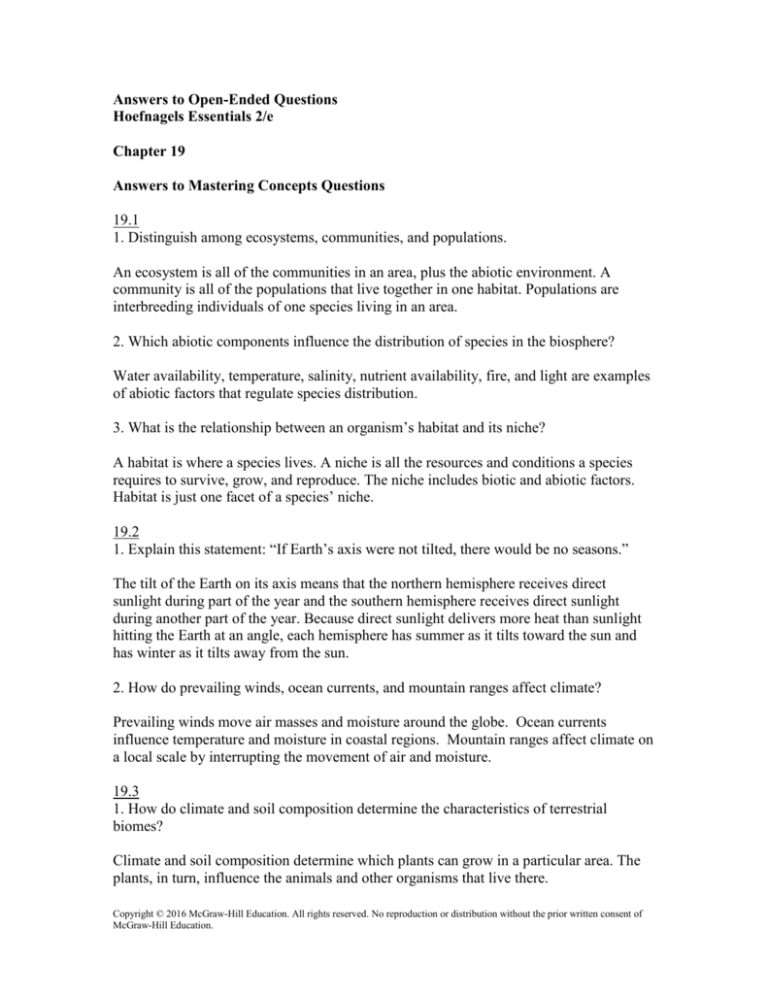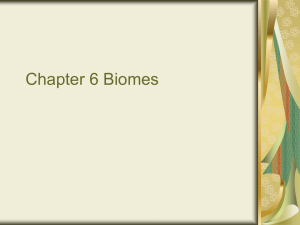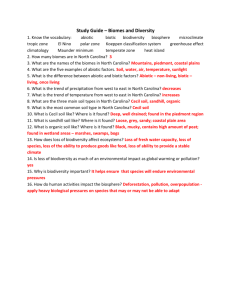
Answers to Open-Ended Questions
Hoefnagels Essentials 2/e
Chapter 19
Answers to Mastering Concepts Questions
19.1
1. Distinguish among ecosystems, communities, and populations.
An ecosystem is all of the communities in an area, plus the abiotic environment. A
community is all of the populations that live together in one habitat. Populations are
interbreeding individuals of one species living in an area.
2. Which abiotic components influence the distribution of species in the biosphere?
Water availability, temperature, salinity, nutrient availability, fire, and light are examples
of abiotic factors that regulate species distribution.
3. What is the relationship between an organism’s habitat and its niche?
A habitat is where a species lives. A niche is all the resources and conditions a species
requires to survive, grow, and reproduce. The niche includes biotic and abiotic factors.
Habitat is just one facet of a species’ niche.
19.2
1. Explain this statement: “If Earth’s axis were not tilted, there would be no seasons.”
The tilt of the Earth on its axis means that the northern hemisphere receives direct
sunlight during part of the year and the southern hemisphere receives direct sunlight
during another part of the year. Because direct sunlight delivers more heat than sunlight
hitting the Earth at an angle, each hemisphere has summer as it tilts toward the sun and
has winter as it tilts away from the sun.
2. How do prevailing winds, ocean currents, and mountain ranges affect climate?
Prevailing winds move air masses and moisture around the globe. Ocean currents
influence temperature and moisture in coastal regions. Mountain ranges affect climate on
a local scale by interrupting the movement of air and moisture.
19.3
1. How do climate and soil composition determine the characteristics of terrestrial
biomes?
Climate and soil composition determine which plants can grow in a particular area. The
plants, in turn, influence the animals and other organisms that live there.
Copyright © 2016 McGraw-Hill Education. All rights reserved. No reproduction or distribution without the prior written consent of
McGraw-Hill Education.
2. Infer one adaptation of plants and one adaptation of animals to the abiotic conditions in
any four biomes.
Answers will vary but should include specific adaptations to climate, fire, or other abiotic
conditions that characterize the biome.
3. Describe the types of organisms that live in each zone of a lake.
The shallow water houses rooted plants and phytoplankton, along with many kinds of
animals, including invertebrates, fishes, and amphibians. In the open water are
phytoplankton, zooplankton, and fishes. Scavengers and decomposers live in the deeper
water, where light does not penetrate.
4. How does a river change from its headwaters to its mouth?
Near the headwaters, streams are small, fast-moving, turbulent, low in nutrients, and high
in dissolved oxygen. As the river flows from its headwaters toward the mouth, it
accumulates water, sediments, and nutrients from numerous streams. Meanwhile, the
channel becomes wider. The water is slower-moving and less turbulent, so it has less
dissolved oxygen. The murky water restricts photosynthesis to the banks and the water
surface.
5. Describe some of the adaptations that characterize organisms in the open ocean,
estuaries, intertidal zones, and coral reefs.
All organisms in the open ocean tolerate high salinity. In the photic zone, floating
phytoplankton carry out photosynthesis. Consumers scoop up the plankton, eat other
animals, or rely on dead material that falls toward the ocean floor. Organisms living in
estuaries have adaptations that allow them to cope with the daily tides, which bring
extreme changes in salinity and moisture. Intertidal organisms can withstand wave action
and daily periods of extreme dryness, wetness, heat, and cold. Coral reef organisms have
adaptations that allow them to live in the nooks and crannies of the reef.
19.4
1. What is the competitive exclusion principle?
The competitive exclusion principle states that two species cannot coexist indefinitely in
the exact same niche. Sooner or later, the one with the greater reproductive rate will
replace the other.
2. List three examples of symbiotic relationships.
In a symbiotic relationship, one species lives in or on another. Three types of symbiosis
include mutualism, commensalism, and parasitism. In mutualism, both partners benefit;
an example is a cow plus the cellulose-digesting microbes in its rumen. In
Copyright © 2016 McGraw-Hill Education. All rights reserved. No reproduction or distribution without the prior written consent of
McGraw-Hill Education.
commensalism, one partner benefits and the other neither benefits nor is harmed by the
relationship; an example is the tiny mites that live, eat, and breed in a human’s hair
follicles. In parasitism, one partner benefits and the other is harmed. Mistletoe growing
on a tree illustrates parasitism because the mistletoe uses water and nutrients that the tree
has acquired.
3. Describe some adaptations that protect against herbivory and predation.
Thorns, milky sap, and poisonous or distasteful chemicals protect against herbivory;
camouflage, warning coloration, weapons, and defensive behaviors protect against
predation.
4. Define coevolution and describe an example.
In coevolution, two species influence the directions of each other’s evolution and
subsequent adaptations. An example is the relationship between a flowering plant and its
pollinator. The flower’s shape may accommodate only one or a few types of pollinators.
In turn, those pollinators have mouthparts that fit only that type of flower.
19.5
1. How do ecologists measure species diversity in a community?
Two measures of species diversity are species richness and relative abundance. Species
richness is the total number of species in a habitat. Relative abundance describes the
proportion of the community that each species represents.
2. How is natural selection apparent in ecological succession?
Succession is a change in species composition over time, and it occurs because one set of
species alters the environmental conditions in such a way that other species can begin to
exploit the habitat. In changing the conditions, they alter the selective forces that
determine which other organisms can survive and reproduce in the habitat.
3. Distinguish between primary and secondary succession.
Primary succession begins in a pristine habitat with no previous soil or community, and
secondary succession occurs in locations that are disturbed but not destroyed.
4. What processes and events contribute to primary and secondary succession?
Primary succession begins with the emergence of a new habitat; secondary succession
begins with disturbance to an existing community. In both cases, pioneer species are the
first to arrive. These species change the environment in ways that permit other species to
thrive. Secondary succession is fastest because the soil-building required for primary
succession takes a long time.
Copyright © 2016 McGraw-Hill Education. All rights reserved. No reproduction or distribution without the prior written consent of
McGraw-Hill Education.
5. How do disturbances prevent true climax communities from developing?
Pockets of local disturbance create patches in different successional stages throughout the
habitat. These disturbances (fires, trees falling, storm damage) happen frequently enough
to prevent a true climax community.
19.6
1. Identify the trophic levels in a food chain.
Primary producers are plants and other autotrophs that can produce their own organic
matter. Primary consumers eat primary producers, secondary consumers eat primary
consumers, and tertiary consumers eat secondary consumers. Decomposers eat dead
organisms and organic wastes.
2. What roles do primary producers and decomposers play in ecosystems?
Primary producers use inorganic nutrients to build organic material, which all consumers
in the ecosystem rely on as an energy source. Decomposers recycle inorganic nutrients to
the ecosystem as they decay organic matter.
3. How efficient is energy transfer between trophic levels?
About 2% to 30% of the energy available to a trophic level is fixed into tissue and made
available to the next higher trophic level, with an overall average of 10%. The rest is lost
to the surroundings as heat.
4. Draw an energy pyramid for an ecosystem with three levels of consumers.
Answers will vary, but the pyramid might include producers (100 kcal), primary
consumers (10 kcal), secondary consumers (1 kcal), and tertiary consumers (0.1 kcal).
5. Explain how biomagnification disproportionately affects organisms at the top of a food
chain.
Biomagnified chemicals are stored in fatty tissues and are not biodegradable. The
chemicals from one trophic level therefore become concentrated into the much smaller
biomass that makes up the next highest level. This accumulation happens in each trophic
level, so top consumers acquire the highest concentrations in their tissues.
19.7
1. Describe the main abiotic reservoirs for the water, carbon, nitrogen, and phosphorus
cycles.
For the water cycle, the main storage reservoirs are large water bodies such as the oceans,
lakes, and rivers. Soil and the atmosphere also store a significant amount of water. For
the carbon cycle, the main abiotic reservoir is the atmosphere. Oceans, carbonate rocks,
Copyright © 2016 McGraw-Hill Education. All rights reserved. No reproduction or distribution without the prior written consent of
McGraw-Hill Education.
soil organic matter, and fossil fuels are other large carbon reservoirs. For the nitrogen
cycle, the main abiotic reservoir is the atmosphere; soil and ocean sediments also store
large amounts of inorganic nitrogen. For the phosphorus cycle, the main abiotic reservoir
is phosphate-rich rocks.
2. What unique roles do microbes play in the nitrogen cycle?
Nitrogen-fixing bacteria and archaea are the only organisms that can transform N2 from
the atmosphere into a form that plants can use. Nitrification and denitrification are also
critical processes that are unique to bacteria and archaea.
3. How can nutrient pollution lead to O2-depleted water?
In the presence of sunlight, nutrients such as nitrogen and phosphorus stimulate the
growth of algae. Initially the algae release O2 in photosynthesis, but soon their cells die
and sink to the bottom of the water column. There, decomposers consume O2 from the
water as they decompose the dead cells of the algae.
Write It Out
1. How does a community differ from an ecosystem?
A community is a group of interacting populations that inhabit the same region. An
ecosystem includes a community plus its nonliving environment.
2. How does the fact that Earth is a sphere tilted on its axis influence the distribution of
life?
Temperature and moisture largely determine which organisms can live in each region of
the globe. The tilt of Earth’s axis and its spherical shape affect these variables. Solar
energy is most intense at the equator, where the sun is nearly overhead all year. The
average temperature falls with distance from the equator because the same amount of
solar energy is distributed over a larger area. The intense sunlight at the equator also
drives the major convection cells, which largely determine how much precipitation falls
in each region. And because the axis is tilted, the northern and southern hemispheres
experience seasonal variations in temperature and moisture.
3. How can the poor soil of the tropical rain forest support such diverse and abundant
life?
The poor soil of the tropical rain forest supports diverse and abundant life because
decomposers and plants constantly recycle nutrients without returning them to the soil.
4. List adaptations of desert and polar ice animals to the climate of their respective
biomes.
Copyright © 2016 McGraw-Hill Education. All rights reserved. No reproduction or distribution without the prior written consent of
McGraw-Hill Education.
Desert animals have adaptations that reduce water loss and that allow them to acquire the
water they need from their food. Animals that live at Earth’s poles face below-freezing
temperatures almost year round. Many of these animals therefore have thick insulation
(fat, feathers, and/or fur) and antifreeze chemicals that prevent ice from forming in their
cells.
5. Use the clues provided to determine which biome houses each of the following four
fish. Yellowfin tuna require salt water; young sea bass occupy areas where fresh and salt
water mix; brook trout require clear, cool, oxygen-rich fresh water; and catfish prefer
warm, quiet fresh water with a slow current.
Yellowfin tuna live in the open ocean; young sea bass live in estuaries; brook trout
occupy mountain streams; catfish live in the slow-moving rivers that characterize flat
land.
6. Three Galapagos finch species have different beak sizes and specialize in different
types of food. Explain how these three species can share the same habitat without driving
each other to extinction.
Since the finches have different diets, they occupy different niches. Competition is
therefore unlikely between these finch species.
7. List examples of adaptations that enable an organism to compete with other species,
live inside another species, find food, and avoid herbivory or predation. How does each
adaptation contribute to the organism’s fitness?
Answers will vary; here are some samples. An example of an adaptation that enables an
organism to compete is the rapid growth of a seedling, which may shade out others as it
acquires light energy. More photosynthesis means more energy for reproduction. An
adaptation that enables one organism to live inside another is the head of a tapeworm,
which has hooks that keep the worm from being flushed out of an animal’s digestive
tract. A worm with such hooks acquires more food than one without, which means more
energy is available for reproduction. An example of an adaptation that helps an animal
find food is an eagle’s keen eyesight. An eagle that can spot small animals acquires more
food than one with poor eyesight. An example of an adaptation that helps an organism
avoid predation is camouflage. An animal that can avoid being eaten (at least before
reproductive age) has a chance at reproductive success.
8. Mountain yellow-legged frogs live in the Sierra Nevada range. Their tadpoles mainly
eat algae. One predator of adult frogs is a garter snake, which is eaten by bullfrogs.
Recently, a chytrid fungus has killed many adult mountain yellow-legged frogs. How
might this change affect the algae, garter snakes, and bullfrogs?
With fewer tadpole grazers, algae populations might increase. When numbers of adult
mountain yellow-legged frogs decline, less food is available to garter snakes, which
Copyright © 2016 McGraw-Hill Education. All rights reserved. No reproduction or distribution without the prior written consent of
McGraw-Hill Education.
might decrease garter snake population size. Fewer garter snakes might lead to lower
numbers of bullfrogs.
9. Suppose a plot of forest is cleared of trees in anticipation of a new shopping mall.
However, after the bulldozers are gone, the company runs out of money, and the land sits
undisturbed for many years. Describe the events that may occur in the years following the
damage to the forest. What are these community changes called?
The land was disturbed but not destroyed. The soil was left intact, and many smaller
plants likely remained. The events of secondary succession would therefore commence.
Fast-growing species like weeds and herbs would be the first to become abundant. Then
grasses and shrubs would become more common. Finally, slower-growing trees would
begin to shade the weeds and grasses. After a few decades, the forest would again be
mature.
10. Imagine that you could build a covered enclosure around a small ecosystem, blocking
out all light and preventing gas exchange with the environment. How would the total
amount of organic material, available energy, and nutrients in the ecosystem change over
time?
Without light, most or all primary production would cease (some autotrophs do not use
light energy to produce food, but most do). With no energy entering the ecosystem,
producers would soon die. Without food, herbivores would also die, followed by
consumers. Decomposers would break down the dead bodies, converting organic matter
into CO2 and H2O and releasing heat. After the last decomposer died, all of the energy in
the ecosystem would have been released as heat and all of the organic material would
have been converted into CO2, H2O, and other inorganic substances. However, the total
amount of nutrients in the ecosystem would not have changed throughout this process.
All of the phosphorus that was once in producers, consumers, and decomposers would
end in the soil. Nitrogen and carbon would be distributed between the atmosphere and the
soil.
11. Alaska salmon spend much of their adult lives in the ocean, eating crustaceans and
small fish. When it is time to mate, they swim upstream to spawn in the rivers where they
hatched. Along the way, bears and other predators catch and eat many salmon. What does
this story tell us about the source and fate of nutrients in ecosystems?
The adult salmon form a link between the biogeochemical cycles of the ocean and the
land. Nutrients therefore move between ecosystems within the biosphere.
Copyright © 2016 McGraw-Hill Education. All rights reserved. No reproduction or distribution without the prior written consent of
McGraw-Hill Education.
Pull It Together
1. What factors determine the location of each biome on Earth?
For terrestrial biomes, temperature and moisture are most important; these depend, in
turn, on latitude, altitude, and distance from the ocean. Fire also maintains some biomes
on land. For aquatic biomes, important factors include latitude, distance from shore, light
penetration, depth/pressure, nutrient availability, dissolved oxygen, and salinity.
2. What types of forests occur on Earth, and what combination of conditions favors each
type?
The main types of forests are rainforests, temperature deciduous forests, temperate
coniferous forests, and taiga. High rainfall and warm temperatures throughout the year
favor the rainforest. In temperate deciduous forests, rainfall is evenly distributed
throughout the year, summers are warm, and winters are cold. Temperate coniferous
forests usually grow where winters are milder and summers are cooler. Taiga forests
grow where winters are very long and cold.
3. What types of terrestrial biomes are likely to have standing and running water? Make
connections between terrestrial and aquatic biomes in the concept map.
Tundra, chaparral, and desert biomes seldom receive precipitation, so standing and
running water are uncommon in these biomes. Grasslands and savannas have seasons
during which rainfall is abundant, so seasonal streams and ponds are likely. Forests often
receive significant precipitation; permanent lakes, streams, and rivers are common.
Many connections between terrestrial and aquatic biomes are possible. They include the
runoff of nutrients from land to water; the ocean currents that moderate the temperature
of nearby land; the animals that occupy both water and land; the oxygen produced by
aquatic producers that replenishes the atmosphere above both water and land; and the
food that humans harvest from the water to consume on land.
4. Add mutualism, commensalism, and parasitism to this concept map.
“Symbiosis” connects with “when both species benefit, is called” to “Mutualism”.
“Symbiosis” connects with “when one species benefits and the other is unharmed, is
called” to “Commensalism”. “Symbiosis” connects with “when one species benefits and
the other is harmed, is called” to “Parasitism”.
5. Make another concept map that shows nutrient cycling on land. Include producers,
consumers, decomposers, carbon, nitrogen, phosphorus, atmosphere, and soil. You may
also add other concepts.
The concept map should show that producers obtain carbon from the atmosphere and
nitrogen and phosphorus from the soil. Producers release carbon to the atmosphere.
Copyright © 2016 McGraw-Hill Education. All rights reserved. No reproduction or distribution without the prior written consent of
McGraw-Hill Education.
Consumers obtain all of these nutrients from producers. Consumers release nitrogen and
phosphorus to the soil and release carbon to both the atmosphere and soil. Decomposers
obtain carbon, nitrogen, and phosphorus from dead organic matter and organic wastes.
Decomposers release nitrogen and phosphorus to the soil and release carbon to the
atmosphere.
Copyright © 2016 McGraw-Hill Education. All rights reserved. No reproduction or distribution without the prior written consent of
McGraw-Hill Education.







